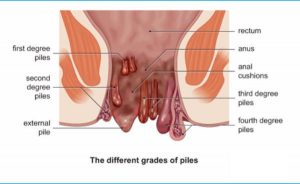Any person can suspicious and determine hemorrhoids. This disease is characterized by specific complaints that give rise to proctologist. In the initial stages, the problem can be treated very effectively at home. But it should be done only after consulting a specialist.
Why hemorrhoids develop
This disease occurs as a result of a baggy swelling of the rectum veins. Painful protrusion and thinning of the walls appears as a result of stagnant blood in the rectal venous plexuses. The blood outflow is disrupted. Thus, hemorrhoidal nodulation is formed. Stagnation causes the formation of blood clots, inflammation, bleeding and pain.
Hemorrhoids is very common disease. The risk of development contributes to a number of predisposing factors.
They are include:
- Hereditary genetic predisposition. If relatives have such problem, then it is required to closely monitor the possible occurrence of pathology in yourself.
- Prone to constipation of the intestines – colitis, dolichosigma, atony.
- Sedentary lifestyle with a long standing, or sitting.
- Physical overloads, which cause an excessive increase in intra-abdominal pressure.
- Severe, complicated pregnancy and pathological births.
- Violation of normal nutrition, overeating, frequent intake of alcohol.
- Infectious diseases localized mainly in the large intestine.
How hemorrhoids look like

A sick person can see only the swallen nodes, which indicates that the stage has been started. A full-fledged diagnosis can only be done by a doctor.
Proctologist examination includes:
- Anal examination. In this case, the doctor can detect external nodes.
- Manual (finger) rectal examination. When palpationthe specialist will determine the nodes behind the anal sphincter.
- Anoscopy. Visual examination of the rectum with the help of a special device – an anoscope. With its help, it is possible to clarify the location of piles .
- Sigmoidoscopy. This method allows you to view completely the entire straight line and most of the sigmoid colon. This study can detect not only hemorrhoids, but also erosive-ulcerative processes, polyps and other formations.
- Colonoscopy. It is used for the diagnosis of disorders of all parts of the large intestine.
The hemorrhoidal process can be internal and external, divided into 4 stages depending on the severity. Diagnosis should exclude diseases that may be similar to varicose veins of the rectum.
A doctor may find:
- anal fissures;
- rectal erosion and ulcers;
- polyps;
- tumor-like formations.
Complaints from a patient with hemorrhoids

Each phase of the disease has its own manifestations:
- At the very beginning, the patient may notice slight bleeding during defecation with constipation (stage 1).
- When the painful nodes fall during the exertion, with or without bleeding, you can diagnose 2-nd stage of the disease. “Piles” are self-correcting.
- If the varicose veins already do not go behind the anal sphincter, but require a finger correction, then we are talking about the 3-rd stage.
- The impossibility of repositioning the hemorrhoidal formations gives the doctor the basis for establishing the last phase – stage 4.
How long does hemorrhoids last?
The course of the painful process is chronic. With the observance of preventive measures and conservative medical measures, it is possible to minimize exacerbations for a long time. Frequent exacerbations, rapid progress, bleeding hemorrhoids allows the surgeon to prescribe surgical treatment.
How to treat yourself at home
If you follow certain recommendations, you can achieve a long-term improvement.
Tips for the prevention of recrudescence of hemorrhoids:
- Dietary rules. In food, you must include many products with vegetable fibre. Dietary supplements that soften the stool are useful. Categorically contraindicated – fried and smoked products, dishes with spicy seasonings. Alcohol should be limited, or even better – completely eliminated. Daily intake of fresh fruits and raw vegetables is required. In the daily diet should be present porridge. It is necessary to pay attention to the drinking regime, not allowing signs of dehydration (dehydration) of the body.
- During the defecation, it is important to exclude excessive tension, you can’t stay in the toilet for a long time. After clearing the intestine, a toilet with warm water and soap is required;
- Several times per day it is useful to make sessile baths with herbal potion, a rising cold shower on the perineal region.
- A daily special therapeutic exercise is required, selected by the instructor.
- A good preventive and curative effect is given by daily jogging and long walking.
- To improve the healing process, you should use anal candles, ointments and creams, which the doctor will write out.
If these measures do not help, then surgery is required.
Operative treatment
Modern level of medicine offers minimally invasive surgery and traditional excision of piles.
With the help of small interventions, the pathological process removes:
- Ligation – ligation of the node with its subsequent falling off.
- Infrared photocoagulation. Scarring of nodal formations by thermal energy.
- Sclerotherapy. Injections of solutions that cause scarring of cones.
- Desarterization. Ligation of blood vessels that supply blood to the rectum veins.
- Electrocoagulation. Therapy of the disease by currents causing the sclerotic process.
With ineffectiveness of minimally invasive interventions, hemorrhoidectomy is shown – excision of nodes by traditional type of operative treatment.
